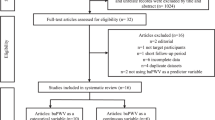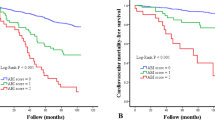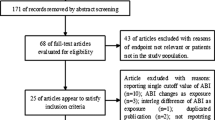Abstract
The ankle–brachial index (ABI) is the ratio of the ankle versus brachial systolic blood pressure. ABI of <0.90 indicates the presence of peripheral arterial disease. Some studies indicated that ABI may correlate with the all-cause mortality. The aim of this study was to assess the prognostic significance of ABI of <0.90 as such predictor of all-cause mortality. In addition, we wished to test the association between ABI and cardiovascular or non-cardiovascular mortality. To this end, we carried out a systematic review of the studies published in MEDLINE that reported both ABI and all-cause mortality. The endpoint of interest was the all-cause mortality, including death from coronary disease, stroke, or other causes. Ten studies, with a total of 22,705 patients, were included in this review. ABI of <0.90 was proved to be associated with an increased risk of all-cause mortality [odds ratio 2.74 (95 % confidence interval 2.03–3.68) and number needed to harm 1.66], as well as with cardiovascular [i.e., death from coronary disease or stroke; respectively, 3.23 (1.98–5.29) and 1.26] and non-cardiovascular mortality [respectively, 2.23 (1.40–3.55) and 1.29]. In conclusion, ABI of <0.9 is useful as a prognostic factor for all-cause mortality.



Similar content being viewed by others
Abbreviations
- ARR:
-
Absolute risk reduction
- NNH:
-
Number needed to harm
- ABI:
-
Ankle–brachial index
- OR:
-
Odds ratio
- ARIC:
-
Atherosclerosis Risk in Communities Study
References
Hertzer, N. R., Beven, E. G., Young, J. R., O’Hara, P. J., Ruschhaupt, W. F, 3rd, Graor, R. A., et al. (1984). Coronary artery disease in peripheral vascular patients. A classification of 1000 coronary angiograms and results of surgical management. Annals of Surgery, 199, 223–233.
Newman, A. B., Siscovick, D. S., Manolio, T. A., Polak, J., Fried, L. P., Borhani, N. O., & Wolfson, S. K. (1993). Ankle-arm index as a marker of atherosclerosis in the Cardiovascular Health Study. Cardiovascular Heart Study (CHS) Collaborative Research Group. Circulation, 88, 837–845.
McKenna, M., Wolfson, S., & Kuller, L. (1991). The ratio of ankle and arm arterial pressure as an independent predictor of mortality. Atherosclerosis, 87, 119–128.
Criqui, M. H., Langer, R. D., Fronek, A., Feigelson, H. S., Klauber, M. R., McCann, T. J., & Browner, D. (1992). Mortality over a period of 10 years in patients with peripheral arterial disease. New England Journal of Medicine, 326, 381–386.
Vogt, M. T., Cauley, J. A., Newman, A. B., Kuller, L. H., & Hulley, S. B. (1993). Decreased ankle/arm blood pressure index and mortality in elderly women. The Journal of the American Medical Association, 270, 465–469.
Newman, A. B., Sutton-Tyrrell, K., Vogt, M. T., & Kuller, M. T. (1993). Morbidity and mortality in hypertensive adults with a low ankle/arm blood pressure index. The Journal of the American Medical Association, 270, 487–489.
Vogt, M. T., McKenna, M., Wolfson, S. K., & Kuller, L. H. (1993). The relationship between ankle brachial index, other atherosclerotic disease, diabetes, smoking and mortality in older men and women. Atherosclerosis, 101, 191–202.
Murabito, J. M., Evans, J. C., Larson, M. G., Nieto, K., Levy, D., & Wilson, P. W. (2003). The ankle-brachial index in the elderly and risk of stroke, coronary disease, and death: The Framingham Study. Archives of Internal Medicine, 163, 1939–1942.
Resnick, H. E., Lindsay, R. S., McDermott, M. M., Devereux, R. B., Jones, K. L., Fabsitz, R. R., & Howard, B. V. (2004). Relationship of high and low ankle brachial index to all-cause and cardiovascular disease mortality: The Strong Heart Study. Circulation, 109, 733–739.
Lamina, C., Meisinger, C., Heid, I. M., Lowel, H., Rantner, B., Koenig, W., & Kronenberg, F. (2006). Association of ankle-brachial index and plaques in the carotid and femoral arteries with cardiovascular events and total mortality in a population-based study with 13 years of follow-up. European Heart Journal, 27, 2580–2587.
Thatipelli, M. R., Pellikka, P. A., McBane, R. D., Rooke, T. W., Rosales, G. A., Hodge, D., et al. (2007). Prognostic value of ankle-brachial index and dobutamine stress echocardiography for cardiovascular morbidity and all-cause mortality in patients with peripheral arterial disease. Journal of Vascular Surgery, 46, 62–70. discussion 70.
Diehm, C., Allenberg, J. R., Pittrow, D., Mahn, M., Tepohl, G., Haberl, R. L., et al. (2009). Mortality and vascular morbidity in older adults with asymptomatic versus symptomatic peripheral artery disease. Circulation, 120, 2053–2061.
Li, X., Luo, Y., Xu, Y., Li, J., & Hu, D. (2010). Relationship of ankle-brachial index with all-cause mortality and cardiovascular mortality after a 3-year follow-up: The China ankle-brachial index cohort study. Journal of Human Hypertension, 24, 111–116.
Suominen, V., Uurto, I., Saarinen, J., Venermo, M., & Salenius, J. (2010). PAD as a risk factor for mortality among patients with elevated ABI–a clinical study. European Journal of Vascular and Endovascular Surgery, 39, 316–322.
Cordero, A., Morillas, P., Bertomeu-Gonzalez, V., Quiles, J., Soria, F., Guindo, J., et al. (2011). Pathological ankle-brachial index is equivalent of advanced age in acute coronary syndromes. European Journal of Clinical Investigation, 41, 1268–1274.
Zheng, Z. J., Sharrett, A. R., Chambless, L. E., Rosamond, W. D., Nieto, F. J., Sheps, D. S., et al. (1997). Associations of ankle-brachial index with clinical coronary heart disease, stroke and preclinical carotid and popliteal atherosclerosis: The Atherosclerosis Risk in Communities (ARIC) Study. Atherosclerosis, 131, 115–125.
Leng, G. C., Fowkes, F. G., Lee, A. J., Dunbar, J., Housley, E., & Ruckley, C. V. (1996). Use of ankle brachial pressure index to predict cardiovascular events and death: A cohort study. British Medical Journal, 313, 1440–1444.
Curb, J. D., Masaki, K., Rodriguez, B. L., Abbott, R. D., Burchfiel, C. M., Chen, R., et al. (1996). Peripheral artery disease and cardiovascular risk factors in the elderly. The Honolulu Heart Program. Arteriosclerosis, Thrombosis, and Vascular Biology, 16, 1495–1500.
Stoffers, H. E., Rinkens, P. E., Kester, A. D., Kaiser, V., & Knottnerus, J. A. (1996). The prevalence of asymptomatic and unrecognized peripheral arterial occlusive disease. International Journal of Epidemiology, 25, 282–290.
Martyn, C. N., Gale, C. R., Jespersen, S., & Sherriff, S. B. (1998). Impaired fetal growth and atherosclerosis of carotid and peripheral arteries. Lancet, 352, 173–178.
Acknowledgments
This study was funded by the Liaoning Provincial Natural Science Foundation of China (Grant No. 2014022032).
Conflict of interest
The authors declare no conflicts of interest.
Author information
Authors and Affiliations
Corresponding author
Rights and permissions
About this article
Cite this article
Qu, B., Liu, Q. & Li, J. Systematic Review of Association Between Low Ankle–Brachial Index and All-Cause Cardiovascular, or Non-cardiovascular Mortality. Cell Biochem Biophys 73, 571–575 (2015). https://doi.org/10.1007/s12013-015-0582-z
Published:
Issue Date:
DOI: https://doi.org/10.1007/s12013-015-0582-z




